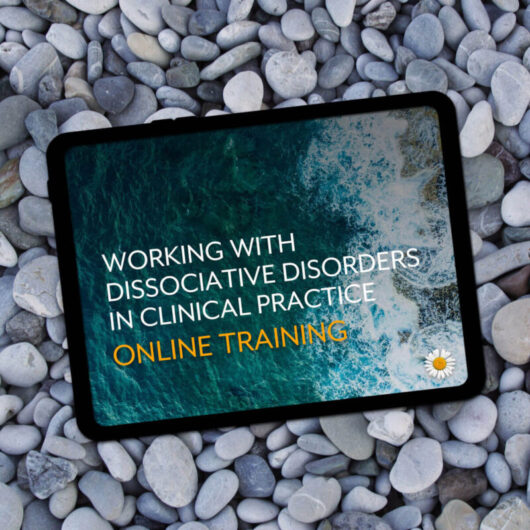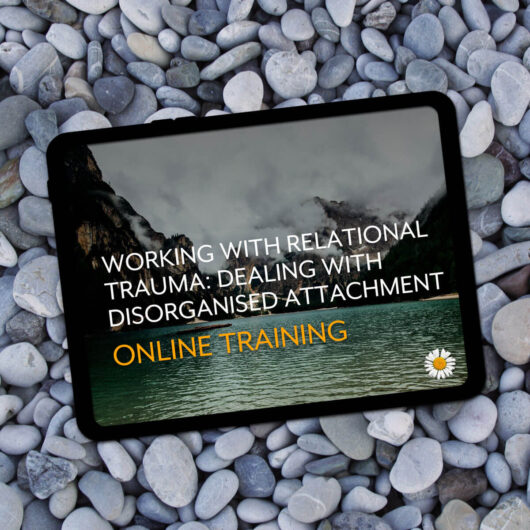Working with trauma is an absolutely essential and rewarding area of counselling and psychotherapy. But it also comes with the risk of secondary trauma, whereby therapists experience the same trauma symptoms as their clients, as a result of their empathic attunement to the client’s narrative.
This course explores what secondary trauma is, why it happens, and most importantly what can be done to mitigate it. An essential training for everyone working with clients with a history of complex trauma.
The following are reviews of Avoiding Secondary Trauma:
- “An excellent course, one which would have been so useful when I started out as a therapist. I don’t remember talking about this in any detail throughout training, it was almost taboo. Here, Carolyn makes it meaningful and really makes you think about vicarious trauma and the process involved. Her reference to supervision was so important as I have had supervision which didn’t go into depth. It is so important to have a supervisor that you trust with the feelings that are scary and shaming. I think that this is an essential course for trainee therapists and it also serves as a reminder to make self-care meaningful for any therapist and understand its role in depth. I have been on Carolyn’s courses for many years and they are always so impactful. I love her way of explaining things. Thank you Carolyn.”
- “This training was invaluable to me working as a counsellor in sexual trauma. It was always a worry that client content could affect my own mental health and impact on the way I work with clients. This has helped me understand secondary trauma and has given me the tools to avoid this from happening.”
- “Really good training. As a counsellor working with trauma it has been important to be more vigilant in my self care and regulation. I find the traffic light system really easy to work with and will be using this with my clients. Thank you, this is really engaging online training – which I usually struggle with !”
- “I have done so much online learning in the last few years and this course and course presentation is among the most engaging, clear, interesting and worthwhile I have done. The clarity with which it is delivered made it a real boost to confidence in how to best to avoid pitfalls and help clients.”
- “This course recommends itself to every therapist that sits across from any trauma story if they imagine any longevity in their practice.”
Course includes:
- Available instantly upon purchase
- 75-minute presentation
- 1.5 hours of CPD with certificate upon completion
- Downloadable resources for a comprehensive learning experience, including:
- Course Notebook with session summaries, reflection questions, space for notes, and references
- PowerPoint handouts (2x per page with space for notes, plus a 4x per page version for easy printing)
- Full PDF transcript
- Lifetime access
- Start/stop and return as often as you like
- Easy to use: only needs a web browser
Individual licence only: for multiple users and information about discounts for organisations, please click here.
Therapeutic Practice Series: Short Course
The very human qualities of empathy and compassion, which are essential to your work as therapists, are also the qualities which put you at risk of secondary trauma: as Homo sapiens, we have evolved to sense and mirror others’ emotions and especially to pick up on and broadcast signals of threat. And so in working closely with clients’ threat-based dysregulation, it’s hard to resist the triggering of our own alarm systems, and therefore to avoid responding with a threat response in fight/flight/freeze ourselves.
In this short course, the first in our new ‘Therapeutic Practice Series’, we explore what secondary (or vicarious) trauma is, and how to mitigate against it. Through an exploration of the research alongside a thorough explanation of the neurobiology of trauma, we will find out who is at risk of secondary trauma, what causes it, and what we can do about it.
This course is aimed primarily at counsellors and psychotherapists but will benefit anyone whose work means they come into contact with or support survivors of trauma.
Questions we will cover:
- What’s the difference between secondary trauma, burnout and compassion fatigue?
- How do you work with trauma without yourself becoming impacted by trauma?
- Is trauma ‘contagious’? If so, what are the neurobiological underpinnings of this?
- What are the key principles of working with trauma that also apply to secondary trauma?
- How does secondary trauma lead to the same symptoms and experiences as primary trauma?
- What are the main ways to mitigate secondary trauma?
- How can you hear your clients’ trauma narratives without becoming overwhelmed by them?
- How can you retain hope and a sense of agency in the light of extreme trauma?
- What happens in the brain and body for secondary trauma to occur?
- How does our capacity for empathy put us at risk for secondary trauma?
- What are the three main signs of secondary trauma?
- What does the research say?
- What is the ‘continuum of cognitive impact’?
- Are you more at risk of secondary trauma if you have a trauma history yourself?
- Are you more at risk of secondary trauma if you have a lot of trauma clients?
- How can you use clear boundaries to mitigate the risk of secondary trauma without becoming unempathic?
The course provides lifetime access, and with downloadable resources including PowerPoint handouts. It is available immediately and on-demand, and can be returned to and replayed as often as desired.
This course is aimed primarily at counsellors and psychotherapists but will benefit anyone whose work means they come into contact with or support survivors of trauma.
SESSION SUMMARIES
Session 1
- Introducing the concept that fear of secondary trauma may in fact be counter-productive
- Background to secondary (‘vicarious’) trauma
- Examining the popular idea that secondary trauma is ‘dose-dependent’
- Introducing the concept of the need to downplay the fear-factor in both primary and secondary trauma
- Exploring the need to tease out the confusion in trauma of when, where and to whom the risk is relevant
- Exploring the need to ‘approach with empathy’ rather than ‘avoid out of fear’
- Understanding the impact that fear of secondary trauma can have on traumatised clients.
Session 2
- Exploring how concept creep has impacted our understanding of the term ‘trauma’
- Exploring definitions of trauma based on a shift of our neurobiology to be sensitised to threat
- Understanding how secondary trauma replicates the same dynamics as primary trauma
- Exploring the steps that need to occur for secondary trauma to take hold
- Examining the brain’s experience of in-person events and imaginal or remembered ones
- Exploring the role of the mirror neuron system
- Understanding the neural basis for empathy and emotional contagion.
Session 3
- Exploring the research base for secondary trauma
- Exploring the correlation of research findings to a trauma perspective
- Exploring the ‘continuum of impact’ on cognitive schemata
- Exploring our personal exposure to trauma and response on this continuum.
Session 4
- Exploring the crossover and distinctions between secondary trauma, burnout and compassion fatigue
- Understanding therapist empathy both in terms of strengths and vulnerabilities
- Depathologising secondary trauma
- Exploring the impact of sitting with trauma being relived by a client in the therapy room
- Mitigation #1: self-awareness of your own capacity
- Exploring the need for rigorous self-assessment of one’s own temporary and permanent capacity
- Examining the inability by some therapists to utilise supervision to process and integrate the trauma they’re witnessing
- Mitigation #2: resolving unresolved trauma to stay in the green zone
- Exploring how one’s own unresolved trauma history can render you vulnerable to secondary trauma
- Understanding how the therapist’s threat response system may be activated by the client’s threat response system.
Session 5
- Mitigation #3: maintaining clear psychological and emotional boundaries
- Exploring the difference between internal and external boundaries
- Exploring what fuzzy internal boundaries may look like
- Exploring what fuzzy external boundaries may look like
- Exploring the difference between attunement and merging
- Exploring how to hold a clear distinction between yourself and the client, and their trauma
- Mitigation #4: Dealing with dysregulation (through self-regulation and co-regulation)
- Understanding that it is normal to be impacted by trauma
- Exploring the ability to re-regulate as key
- Exploring the need for human support to re-regulate and integrate
- Examining signs of persistent dysregulation
- Exploring the needs for systems of re-regulation to counter secondary trauma.
Session 6
- Mitigation #5: processing and integrating what you’ve heard and witnessed
- Exploring the principle of ‘re-regulation before integration’
- Examining the impact of trauma on our worldview
- Exploring the emotional and cognitive impact of a shift in worldview
- Exploring the need for ‘counter worlds’
- Mitigation #6: switching our focus from bears to berries
- Understanding the power of deliberately switching our focus away from danger to beauty
- Exploring the importance of ‘micro-moments of joy’
- Exploring the importance of integrating non-threat into the threat worldview
Session 7
- Mitigation #7: empowerment to overcome powerlessness and freeze
- Exploring the reality of powerlessness at the moment of trauma
- Understanding trauma recovery and resilience as re-empowerment
- Exploring the importance of autonomy, agency and self-efficacy
- Exploring potential contrasting perspectives between therapist and client
- Understanding the importance of the therapist ‘coming alongside’ to counter the trauma belief that ‘There’s nobody there’
- Understanding the impact of shame gremlins on negative self-talk, and how this increases the risk of secondary
- trauma
- Mitigation #8: holding hope and optimism
- Understanding how the red zone of freeze in trauma manifests in long-term hopelessness
- Exploring the importance of the therapist’s own strong belief system around recovery from trauma
- Exploring the need for both external and internal ‘beacons of hope’
- Exploring the need for early reaching out for help when stuck, rather than spiralling into a vortex of powerlessness
- Conclusion
- Summarising the ways in which we have control over many of the factors which lead to secondary trauma
- Re-emphasising the need for peer support and unconditional positive regard in mitigating secondary trauma.



